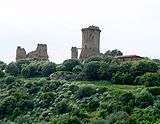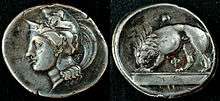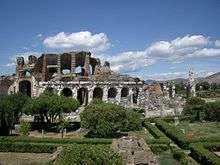- Not to be confused with the municipality of Novi Velia. For other uses, see Velia (disambiguation).
Velia|
View of the excavations and the tower at Velia |
|
|
| Alternate name |
Hyele, Ele, Elea |
|---|
| Location |
Velia, Province of Salerno, Campania, Italy |
|---|
| Region |
Magna Graecia |
|---|
| Coordinates |
40°09′39″N 15°09′18″E / 40.16083°N 15.15500°E / 40.16083; 15.15500Coordinates: 40°09′39″N 15°09′18″E / 40.16083°N 15.15500°E / 40.16083; 15.15500 |
|---|
| Type |
Settlement |
|---|
| History |
|---|
| Builder |
Settlers from Phocaea |
|---|
| Founded |
Between 538 and 535 BC |
|---|
| Associated with |
Parmenides, Zeno, Statius |
|---|
| Site notes |
|---|
| Management |
Soprintendenza per i Beni Archeologici di Salerno, Avellino, Benevento e Caserta |
|---|
| Website |
Parco archeologico di Elea-Velia (Italian) |
|---|
|
|
|---|
| Official name |
Cilento and Vallo di Diano National Park with the Archaeological sites of Paestum and Velia, and the Certosa di Padula |
|---|
| Type |
Cultural |
|---|
| Criteria |
iii, iv |
|---|
| Designated |
1998 (22nd session) |
|---|
| Reference no. |
842 |
|---|
| Region |
Europe and North America |
|---|
Velia was an ancient city of Magna Graecia on the coast of the Tyrrhenian Sea. It was originally founded by Greeks from Phocaea as Hyele (Ancient Greek: Ὑέλη) around 538–535 BC. The name later changed to Ele and then Elea (Ancient Greek: Ἐλέα) before it became known by its current Latin and Italian name. Its ruins are located in the Cilento region near the modern village Velia, which was named after the ancient city. The village is a frazione of the comune Ascea in the Province of Salerno, Campania, Italy.
The city was known for being the home of the philosophers Parmenides and Zeno of Elea, as well as the Eleatic school of which they were a part. The site of the acropolis of ancient Elea was once a promontory called Castello a Mare, meaning "castle on the sea" in Italian. It now lies inland and was renamed to Castellammare della Bruca in the Middle Ages.
Geography
The town is situated close to the Tyrrhenian coast in a hill zone nearby Marina di Casalvelino and Marina di Ascea, on a road linking Agropoli to the southern Cilentan Coast. Its population is mainly located in the plain by the sea (surrounding the southern part of the ancient ruins) and in the hill zones of Enotria, Bosco and Scifro. Velia also had a railway station on the Naples-Salerno-Reggio Calabria line, closed at the end of the 1970s.
History
According to Herodotus, in 545 BC Ionian Greeks fled Phocaea, in modern Turkey, which was being besieged by the Persians. After some wanderings (8 to 10 years) at sea, they stopped in Reggio Calabria, where they were probably joined by Xenophanes, who was at the time at Messina, and then moved north along the coast and founded the town of Hyele, later renamed Ele and then, eventually, Elea. The location is nearly at the same latitude as Phocaea.
Elea was not conquered by the Lucanians, but eventually joined Rome in 273 BC and was included in ancient Lucania. According to Book 6 of Virgil's Aeneid, Velia is the place where the body of Palinurus washed ashore.[1]
Ruins
Remains of the city walls, with traces of one gate and several towers, of a total length of over three miles, still exist, and belong to three different periods, in all of which the crystalline limestone of the locality is used. Bricks were also employed in later times; their form is peculiar to this place, each having two rectangular channels on one side, and being about 1.5 in. square, with a thickness of nearly 4 in. They all bear Greek brick-stamps. There are some remains of cisterns on the site, and, various other traces of buildings.
Ruins of the Greek theater
Eleatics
The Eleatics were a school of pre-Socratic philosophers. The group was founded in the early 5th century BC by Parmenides. Other members of the school included Zeno of Elea and Melissus of Samos. Xenophanes is sometimes included in the list, though there is some dispute over this.
Famous residents
Gallery
| The Porta Rosa ( Pink Gate, but Rosa, here, is intended as a given name), made of dry masonry of sandstone bricks, a rare exemplar of a Greek arch, circa 4th century BC |
| The Porta Rosa road was the main street of Elea, circa 4th-3rd centuries BC |
| The medieval tower of Velia built out of a Greek temple |
|
See also
References
- ↑ Frederick Ahl (trans.), ed. (2007). Virgil's Aeneid. Oxford UP. pp. 139–40. ISBN 978-0-19-923195-9.
External links
 |
Wikimedia Commons has media related to Velia. |


_-_theatre.jpg)
 This article incorporates text from a publication now in the public domain: Chisholm, Hugh, ed. (1911). Encyclopædia Britannica (11th ed.). Cambridge University Press.
This article incorporates text from a publication now in the public domain: Chisholm, Hugh, ed. (1911). Encyclopædia Britannica (11th ed.). Cambridge University Press.







